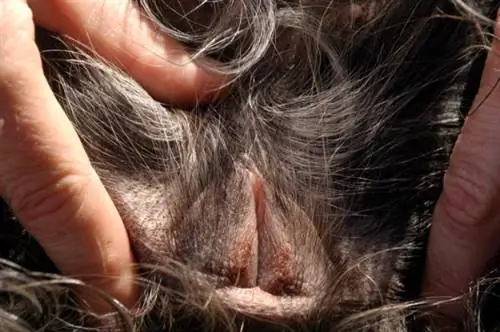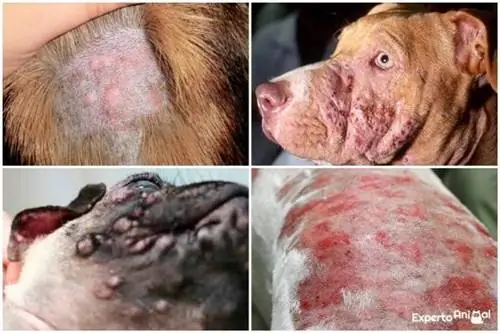- Author Carl Johnson [email protected].
- Public 2023-12-16 06:19.
- Last modified 2025-01-23 08:59.

If we notice that our dog has hives on her vulva or some redness in that delicate area, it is important that we go to the vet. It is very normal that the first symptom that alerts us is the insistent licking of the area. Precisely this action can aggravate the problem, hence the importance of contacting the vet soon.
In this article on our site we will see that the most common causes of hives on the vulva are contact dermatitis and pyoderma of the folds. However, they are not the only ones that can explain why your dog has hives on her vulva, so read on and see a specialist.
Wheals on the vulva of the bitch due to contact dermatitis
When we talk about contact dermatitis we refer to the reaction that occurs on the skin in the direct presence of an irritating substance. The vulva is an area that is relatively easily exposed to this type of agent. When the dog sits or even lies down in certain positions, this contact with chemical products that cause this type of dermatitis can occur. They can be detergents, solvents, soaps, etc.
The bitches that have welts on the vulva usually have the area devoid of hair or with little quantity, hence the contact is easier and more intense due to the lack of protection. Depending on the causative agent, we can see dermatitis in other areas with similar characteristics such as the abdomen, nose, hocks, feet or lips.
A single exposure to the irritant is enough for it to be triggered. We will notice in the affected area red lumps and inflamed skin. The bitch will feel very itchy Scratching or biting aggravates the condition and forms moist spots that ooze, blisters or crusts. It can get infected if we don't treat in time. In addition, changes occur in the appearance of the skin, it becomes rough and the hair falls out. It is important that we try to identify the triggering product of the reaction to prevent future exposures. You have to go to the vet to prescribe both topical and oral anti-inflammatories to relieve itching and swelling.
For more information, see our article on Dermatitis in dogs - Types, symptoms and treatment.
Wheals on the vulva of the bitch due to pyoderma of the folds
If our dog has hives on her vulva, another possible cause could be a bacterial infection called pyoderma. In this case, it occurs in a risk area, such as the folds that form around the vulva. This friction between skin surfaces causes the skin to become moist and inflamed, creating a perfect habitat for bacterial proliferation, which is the cause of infection.
In addition to irritation, itching and inflammation of the affected area, it will give off a very bad smell It should be noted that pyoderma of the folds vulvae is more common in overweight female dogs. The key to controlling this process is to dry the folds and clean them with a disinfectant shampoo prescribed by the vet. In some cases it is also necessary to add an antibiotic and anti-inflammatory ointment to the treatment.
If you think this is the cause of your dog's vulvar welts, see the article Pyoderma in Dogs - Symptoms and Treatment for more details.

Pimples around the bitch's vulva due to folliculitis
Folliculitis is an infection originating from the hair folliclesWhat we will see on the skin are small pimples in the mildest cases, but this condition can worsen until the development of pustules and scabs. It is a condition that usually occurs in the inguinal area, but also in the axillary or throughout the abdomen. Folliculitis can make us think that our dog has welts on her vulva or pimples around it, but we already see that it is an infection that must be treated.
It is necessary to go to the vet because sometimes folliculitis is associated with other diseases that this professional will also have to diagnose and treat. Against folliculitis it is usual to prescribe baths, but deeper cases also need systemic medication. It is a long treatment that can last up to eight weeks.
Transmissible venereal tumor as a cause of hives on the vulva of the bitch
The transmissible venereal tumor is a rare pathology, but we mention it because its signs could make us think that our dog has hives on the vulva. These venereal tumors are contagious, since the tumor cells have the ability to move from one dog to another, especially during mating, but also by licking, biting or scratches. Its clinical manifestation is lumps, solitary or multiple, that can ulcerate and be confused with hives.
In addition to the vulva, they can appear in the vagina, perineum, face, nose or legs We must go to the veterinarian because they are transmissible and, although rare, could metastasize. They are treated with chemotherapy for several weeks or with radiotherapy in a single session. Castration is also recommended to avoid future contagion.






